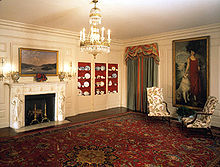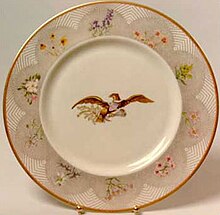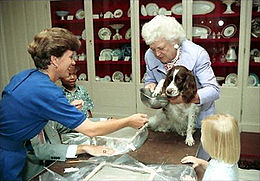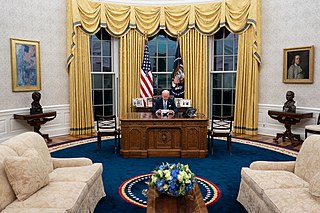
The Oval Office is the formal working space of the President of the United States. Part of the Executive Office of the President of the United States, it is located in the West Wing of the White House, in Washington, D.C.

The Blue Room is one of three state parlors on the first floor in the White House, the residence of the president of the United States. It is distinctive for its oval shape. The room is used for receptions and receiving lines and is occasionally set for small dinners. President Grover Cleveland married Frances Folsom in the room on June 2, 1886, the only wedding of a President and First Lady in the White House. The room is traditionally decorated in shades of blue. With the Yellow Oval Room above it and the Diplomatic Reception Room below it, the Blue Room is one of three oval rooms in James Hoban's original design for the White House.
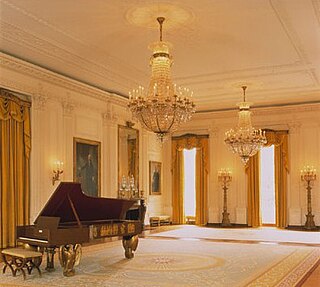
The East Room is an event and reception room in the Executive Residence, which is a building of the White House complex, the home of the president of the United States. The East Room is the largest room in the Executive Residence; it is used for dances, receptions, press conferences, ceremonies, concerts, and banquets. The East Room was one of the last rooms to be finished and decorated, and it has undergone substantial redecoration over the past two centuries. Since 1964, the Committee for the Preservation of the White House has, by executive order, advised the president of the United States and first lady on the decor, preservation, and conservation of the East Room and other public rooms at the White House.
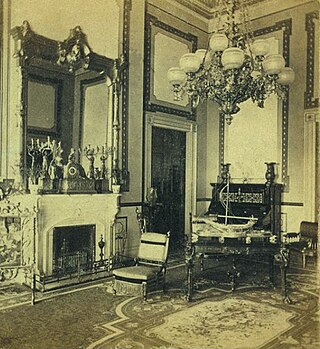
The Red Room is one of three state parlors on the State Floor in the White House, the Washington D.C. home of the president of the United States. The room has served as a parlor and music room, and recent presidents have held small dinner parties in it. It has been traditionally decorated in shades of red. The room is approximately 28 by 22.5 feet. It has six doors, which open into the Cross Hall, Blue Room, South Portico, and State Dining Room.

The Green Room is one of three state parlors on the first floor of the White House, the home of the president of the United States. It is used for small receptions and teas. During a state dinner, guests are served cocktails in the three state parlors before the president, first lady, and a visiting head of state descend the Grand Staircase for dinner. The room is traditionally decorated in shades of green. The room is approximately 28 by 22.5 feet. It has six doors, which open into the Cross Hall, East Room, South Portico, and Blue Room.

The State Dining Room is the larger of two dining rooms on the State Floor of the Executive Residence of the White House, the home of the president of the United States in Washington, D.C. It is used for receptions, luncheons, larger formal dinners, and state dinners for visiting heads of state on state visits. The room seats 140 and measures approximately 48 by 36 feet.

The White House Library is on the Ground Floor of the White House, the official home of the president of the United States. The room is approximately 27 by 23 feet and is in the northeast corner of the ground floor. The library is used for teas and meetings hosted by the president and first lady. During the 1950s reconstruction of the White House, old building lumber from the house was salvaged and re-made into wall paneling for this room. Several basement rooms in the White House are paneled with salvaged building materials from the pre-reconstructed White House.

The Vermeil Room is located on the ground floor of the White House, the official residence of the president of the United States. The room houses a collection of silver-gilt or vermeil tableware, a 1956 bequest to the White House by Margaret Thompson Biddle. Portraits of American First Ladies hang in the room.

The Diplomatic Reception Room is one of three oval rooms in the Executive Residence of the White House, the official home of the president of the United States. It is located on the ground floor and is used as an entrance from the South Lawn and a reception room for foreign ambassadors to present their credentials, a ceremony formerly conducted in the Blue Room. The room is the point of entry to the White House for a visiting head of state following the State Arrival Ceremony on the South Lawn. The room has four doors, which lead to the Map Room, the Center Hall, the China Room, and a vestibule that leads to the South Lawn.

The Map Room is a room on the ground floor of the White House, the official home of the president of the United States.

The Cross Hall is a broad hallway on the first floor in the White House, the official residence of the president of the United States. It runs east to west connecting the State Dining Room with the East Room. The room is used for receiving lines following a State Arrival Ceremony on the South Lawn, or a procession of the President and a visiting head of state and their spouses.

The Yellow Oval Room is an oval room located on the south side of the second floor in the White House, the official residence of the president of the United States. First used as a drawing room in the John Adams administration, it has been used as a library, office, and family parlor. Today the Yellow Oval Room is used for small receptions and for greeting heads of state immediately before a State Dinner.

The Treaty Room is located on the second floor of the White House, the official residence of the president of the United States. The room is a part of the first family's private apartments and is used as a study by the president.

The White House Office of the Curator is charged with the conservation and study of the collection of fine art, furniture, and decorative objects used to furnish both the public and private rooms of the White House as an official residence and as an accredited historic house museum.

The Cabinet Room is the meeting room for the officials and advisors to the president of the United States who constitute the Cabinet of the United States. The room is located in the West Wing of the White House, adjoining the Oval Office, and looks out upon the White House Rose Garden.

The Roosevelt Room is a meeting room in the West Wing of the White House, the home and main workplace of the president of the United States. Located in the center of the wing, near the Oval Office, it is named after two related U.S. presidents, Theodore Roosevelt and Franklin D. Roosevelt, who contributed to the wing's design.
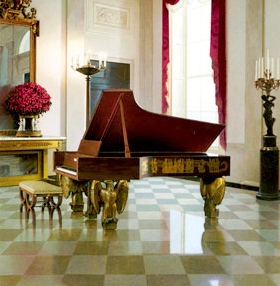
The Entrance Hall is the primary and formal entrance to the White House, the official residence of the president of the United States. The room is rectilinear in shape and measures approximately 31 by 44 feet. Located on the State Floor, the room is entered from outdoors through the North Portico, which faces the North Lawn and Pennsylvania Avenue. The south side of the room opens to the Cross Hall through a screen of paired Roman Doric columns. The east wall opens to the Grand Staircase.
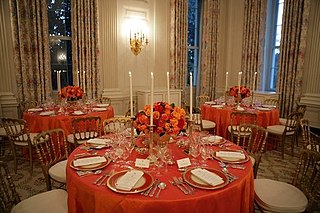
The White House china refers to the various patterns of china (porcelain) used for serving and eating food in the White House, home of the president of the United States. Different china services have been ordered and used by different presidential administrations. The White House collection of china is housed in the White House China Room. Not every administration created its own service, but portions of all china services created for the White House are now in the China Room collection. Some of the older china services are used for small private dinners in the President's Dining Room on the Second Floor.

The Grand Staircase is the chief stairway connecting the State Floor and the Second Floor of the White House, the official home of the president of the United States. The stairway is primarily used for a ceremony called the Presidential Entrance March. The present Grand Staircase, the fourth staircase occupying the same general space, was completed in 1952 as a part of the Truman White House reconstruction. The Grand Staircase is entered on the State Floor from the Entrance Hall.

The Center Hall is a broad central hallway on the second floor of the White House, home of the president of the United States. It runs east to west connecting the East Sitting Hall with the West Sitting Hall. It allows access to the elevator vestibule, East and West Bedrooms, the Grand Staircase, Yellow Oval Room, the first family's private living room, and the president's bedroom.
